|
|
|
Sort Order |
|
|
|
Items / Page
|
|
|
|
|
|
|
| Srl | Item |
| 1 |
ID:
103853
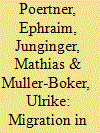

|
|
|
|
|
| Publication |
2011.
|
| Summary/Abstract |
In Nepal, international labor migration to India and overseas, as well as internal migration to the rural Nepalese lowlands, is of high socioeconomic significance. Scholarly debates about migration in Nepal have gradually shifted from an economic to a more holistic perspective, also incorporating social dimensions. However, little evidence has been generated about internal migration to urban destinations and the potential linkages between international and internal migration. This article draws on Bourdieu's "Theory of Practice" and sees migration as a social practice. Accordingly, migration practice is regarded as a strategy social agents apply to increase or transfer capitals and ultimately secure or improve their social position. Evidence for this argument is based on a qualitative case study of ruralto- urban migrants in Far West Nepal conducted in July and August 2009. The study at hand addresses linkages between internal and international migration practices and provides insight about a social stratum that is often neglected in migration research: the middle class and, more precisely, government employees. The authors show that social relations are crucial for channeling internal migration to a specific destination. Furthermore, they unveil how internal migration is connected to the international labor migration of former generations. Finally, the authors examine how migration strategies adopted over generations create multi-local social networks rooted in the family's place of origin.
|
|
|
|
|
|
|
|
|
|
|
|
|
|
|
|
| 2 |
ID:
103857
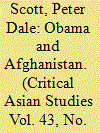

|
|
|
|
|
| Publication |
2011.
|
| Summary/Abstract |
Obama and Afghanistan" is excerpted from Peter Dale Scott, American War Machine: Deep Politics, the CIA Global Drug Connection, and the Road to Afghanistan (chapter 10), published in 2010 by Rowman&Littlefield (Lanham, Md.).
|
|
|
|
|
|
|
|
|
|
|
|
|
|
|
|
| 3 |
ID:
103854
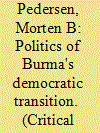

|
|
|
|
|
| Publication |
2011.
|
| Summary/Abstract |
Many have dismissed the military-controlled transition to "democracy" in Burma as a sham that will only further entrench military rule. Others, however, view it as an opportunity to break the army's long-standing stranglehold on power and start a process of gradual reform. The present article considers the transition from a strategic perspective. After briefly revisiting the history of military rule in Burma, it examines the politics of the transition and considers possible scenarios in the short, medium, and longer term. It concludes that, although the military clearly has no intentions of surrendering control of the government, new political leaders, institutions, and processes might open opportunities to improve governance and, over time, transform politics, especially if democrats play their cards right.
|
|
|
|
|
|
|
|
|
|
|
|
|
|
|
|
| 4 |
ID:
103856
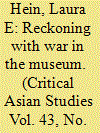

|
|
|
|
|
| Publication |
2011.
|
| Summary/Abstract |
How do people handle their regret at having believed that a foolish war was not just acceptable but necessary? Japan after World War II provides an instructive example. Many contrite Japanese revisited the aesthetic realm, looking for ways to interpret culture that did not convey the values of fascism, such as glorifying willing surrender to a powerful leader. They saw their task as engendering an individual aesthetic and therefore political subjectivity, so that Japanese would in the future more bravely resist state violence at home and abroad. These individuals saw culture as intrinsically political rather than as a refuge from politics. Recognizing the difficulty in countering fascist culture through ideas alone, they also created what economists today call "capacity building" institutions to help them do so, such as Japan's first museum dedicated solely to modern art, the Kamakura Museum of Modern Art, established in 1951. The founders of the Kamakura Museum self-consciously set out to create a new institution that would embody a democratic aesthetic and so prevent-they hoped-Japan from repeating the disastrous experience of war. The curators argued for diverse and dynamic modernities, a concept that parried both the idea that artistically Japan was a pale copy of modern Europe and the notion of a single national culture in Japan or elsewhere. At the same time, however, the legacy of the war was visible in an entirely different and less admirable way in the museum curators' stance toward Asian modernity beyond Japan and its evasion of Japan's responsibility for the wartime devastation of China.
|
|
|
|
|
|
|
|
|
|
|
|
|
|
|
|
| 5 |
ID:
103855
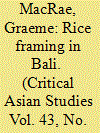

|
|
|
|
|
| Publication |
2011.
|
| Summary/Abstract |
All is not well with agriculture in Southeast Asia. The productivity gains of the Green Revolution have slowed and even reversed and environmental problems and shortages of water and land are evident. At the same time changing world markets are shifting the dynamics of national agricultural economies. But from the point of view of farmers themselves, it is their season-to-season economic survival that is at stake. Bali is in some ways typical of other agricultural areas in the region, but it is also a special case because of its distinctive economic and cultural environment dominated by tourism. In this environment, farmers are doubly marginalized. At the same time the island offers them unique market opportunities for premium and organic produce. This article examines the ways in which these opportunities have been approached and describes their varying degrees of success. It focuses especially on one project that has been successful in reducing production costs by conversion to organic production, but less so in marketing its produce. It argues finally for the need for integrated studies of the entire rice production/marketing complex, especially from the bottom-up point of view of farmers.
|
|
|
|
|
|
|
|
|
|
|
|
|
|
|
|
| 6 |
ID:
103852


|
|
|
|
|
| Publication |
2011.
|
| Summary/Abstract |
This article critically appraises and evaluates tourism strategies and heritage management in Luang Prabang, Lao People's Democratic Republic, a Unescodesignated "world heritage" city. Luang Prabang is widely regarded as one of the most significant heritage cities in Southeast Asia. The city is renowned for its Buddhist and royal culture and also its historic vernacular Lao, French, and Lao-French architecture. The city earned world heritage status in 1995, but since that time the boom in in-bound Asian tourism has put pressures on Luang Prabang's authenticity and, for some, called into question the validity of its world heritage status. This article examines these substantial and wide-ranging pressures and argues that the growth in tourism and the treatment of Luang Prabang's heritage are symptoms of broader regional processes of political and economic change, including the expansion of Chinese and Korean investment and the growth of intra-regional tourism. The authors argue that it is unreasonable to expect traditional heritage management mechanisms, including the world heritage listing, to be able to cope with the pressures on sites like Luang Prabang. The very least that is required, the authors contend, is an expanded understanding of the context in which heritage places sit, and the authors make a case that the cultural landscapes approach, combined with explicit concern for intangible heritage and poverty alleviation, must be at the core of any strategy for long-term protection of the city's cultural heritage values.
|
|
|
|
|
|
|
|
|
|
|
|
|
|
|
|
|
|
|
|
|